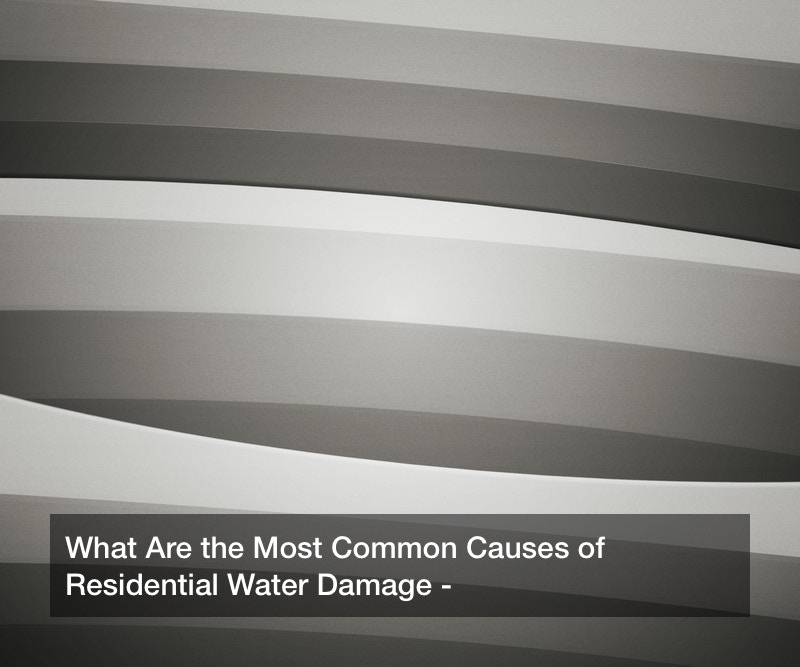
Home improvement is an important part of owning a home — and oftentimes, it can be a necessary task. In 2017 alone, home improvement spending increased by nearly 14%, with both new and old homes benefiting from revisions. However, while improving your home to suit your style is one thing, improving it to prevent damage is another.
Many homes fall victim to water damage and not even new houses are immune. As a homeowner, it’s important to understand the causes of water damage in homes so that you can prevent it before it becomes an overly expensive problem.
To help give you a better idea of what to look for and how you can prevent water damage, here are five of the most common causes.

1. Roof Leaks
A leaking roof is one of the most common causes of water damage in homes and it is something that can easily sneak up on you. Because it can be hard to see roof damage, cracks and missing singles can go undetected until moisture starts to leak inside.
Damaged flashing, incorrect materials, broken or missing shingles, and ice dams can all lead to interior water damage if you’re not careful. Improperly installed or damaged flashing — the metal around vent pipes, skylights, and chimneys — can allow water inside creating drips and even damaging mold growth. Similarly, broken or blown away singles can create weak points where water can enter.
The most common signs of roof leaks can include watermarks on the ceilings and walls, peeling around skylights, mold growth around chimneys, attic wood rot, mold in attic insulation, water leaks during storms or snow melts, and crumbling drywall. If you have noticed any of these signs, it’s a good idea to have your roof checked out to ensure that all areas of weakness are identified. Once all necessary roof repairs have been completed, it’s also a good idea to invest in yearly roof inspections to prevent problems from springing back up. Roof inspections are recommended at least once a year, but optimally you should be inspected once during the springtime and again before winter. This helps ensure that you don’t have damage from winter snow or summer storms leading into the next season.
2. HVAC Water Damage
An HVAC system can cause a great deal of water damage if not maintained correctly. This can be one of the most commonly found causes of water damage in homes with older systems, especially if you are unsure of how well the previous owner maintained the unit. Usually, problems arise when drains get clogged, pipes get disconnected, or the evaporator coils freeze. If you’re noticing water around your HVAC, it’s a good idea to shut down the system and call a professional HVAC service to prevent further damage.
If you’re not having problems yet but want to avoid them in the future, there are some steps you can take to help stave off any HVAC water damage. Firstly, always remember to change your filter as recommended. This helps prevent your system from having to overwork which can lead to freezing and defrosting evaporator coils. You should also take care to clean the condenser — the exterior part of your AC or heat pump — to ensure buildup hasn’t blocked airflow. All dirt and debris buildup should be cleaned out at least once a year, usually around the beginning of spring. You should also make sure that all shrubs or bushes are at least two feet away from the unit, to ensure it has proper airflow.
You may also wish to consider having a professional inspection conducted yearly or every other year. This will not only ensure that your system is working properly, but a professional will be able to point out any problems that you wouldn’t be able to. They will also be able to inspect problems in the ductwork, AC compressors, and thermostat that would be difficult or dangerous for you to try to do on your own.

3. Clogged Drains
Clogged drains are another of the most common causes of water damage in homes and can be difficult to handle if you’re not a professional. If a clog becomes too advanced, it can cause damage to pipes creating leaks. Water damage from clogged drains can cause damage to the interior, exterior, and foundation of your home, in addition to being potentially hazardous to your health.
Interestingly, severe clogs can actually irritate pre-existing health conditions such as asthma or sensitive skin conditions. Being near leaking wastewater can then lead to more frequent asthma attacks or skin irritations. The longer the water is allowed to sit due to a clog, the more contaminated it becomes — further aggravating these problems. While toilet clogs are the most significant contributors to these problems, even clogs without contaminated water can risk becoming contaminated if allowed to fester. When water is unmoving, bacteria such as Legionella can begin to grow. This can lead to the development of Legionnaires’ Disease, a condition which can cause shortness of breath, chest pain, and gastrointestinal problems.
While common clogs might not seem like a huge deal immediately if you’re experiencing frequent problems, it’s in your best interest to call in a professional. Even if you can get the water moving again, without addressing potential underlying issues the clogs can continue happening. Additionally, you may also put yourself at risk of exposure to contaminants that could make you sick. In this instance, it’s best to leave the problem to a professional.
4. Septic Flooding
In areas that are prone to heavy rainfall and flooding, a flooded septic system can be one of the most common causes of water damage in homes. If your property was recently flooded, don’t hurry to start using it ASAP. Even if your home hasn’t been damaged by flooding, if a backup of water is created, you could end up with water coming back into the house. While calling in a professional is your best course of action, there are some steps you can take to help mitigate any issues.
Firstly, know where your septic tank is located on your property, as well as the drain field. Calculate how deep the septic tank is by probing it with a metal rod. Most only sit two or three feet beneath the surface. You’ll also want to know how deep the drain field is. This information will help you determine how flooded everything is underground.
To check the depth of the groundwater by the tank and drain field, either use a soil probe or dig a hole with an auger 10 feet from the tank and 20 feet from the drain field. If you notice that the water table is above the depth of the tank, don’t have the tank pumped and don’t start using your septic system. If the water table is three feet below the top of the tank, but the drain field is still flooded, the septic tank may be used for holding. You can have in commercially pumped; however, don’t remove more than half its volume. If too much is removed, it could end up floating upward and damaging the pipes and inlet.
Until the flooding has receded and any damage has been addressed, it’s important to halt or reduce any water used in your home. If your system still isn’t working correctly after the water table has receded, call in a professional to ensure there isn’t damage that has been missed.

5. Refrigerators and Freezers
Yes, as strange as it might sound, leaking refrigerators and freezers are one of the most common causes of water damage in homes. While it isn’t something that happens suddenly, if not caught soon enough, the damage can add up.
Water damage from refrigerators and freezers often happens when the plastic water line behind them starts to weaken and crack. This results in a slow leak that, over the years, can damage the floor and wall beneath and behind it. Ice maker leaks and condensation buildup can also cause similar problems, and depending on the material of your floor, it can spell disaster.
If you are able to catch the leak quickly enough, mopping up the spill and letting the floor completely dry might be enough to prevent any significant damage. However, if the leak has been going on for too long, you’ll likely need the flooring replaced as well as the wall integrity assessed. Because water damage can lead to mold growth, if enough time has passed you may be at risk, even if it hasn’t started growing yet. If you’re planning on having the flooring redone, speak with your remodeling contractor about assessing your drywall, just to be on the safe side.
Water damage like this may seem inevitable, especially given how silent and undetectable it can be. But fortunately, there are ways to prevent it. Take care to regularly check the back of your fridge and freezer and remove any built-up dust and debris. You should also check for any hard water build up in the water line, as that can go on to create leaks. If possible, consider upgrading your plastic water lines to more reliable steel ones, to further decrease the likelihood of leaks.
You can also consider investing in water alarms. These small devices can be placed behind your refrigerator, under your sink, and even behind your dishwasher to alert you to any unseen leaks. Because they sound as soon as they come in contact with water, you’ll never have to worry about leaks in hard to see areas again.
Additional Causes of Water Damage in Homes
While these five are the most common, other causes can be:
- Corroded pipes
- Damaged pipe joints
- Frozen pipes
- Broken seals
- Excessive water pressure
- Tree roots
All of these can be causes of water damage in homes. If you’ve noticed any of these issues, or have found water where it shouldn’t be, you should consider calling a plumber immediately.

Taking Care of Your Home
Identifying and taking care of these common causes of water damage in homes can help ensure that you won’t end up with more costly repairs in the future. While some may seem small, if left alone they can continue to cause damage, some of which can create additional problems — such as weakened foundations or mold growth — that can end up decreasing both the value and safety of your home.
This can be especially true if you are considering selling your home at any point in the future. You’ll want to rectify these issues so that home buyers won’t have a reason to walk away. Upgrades and improvements that prevent water damage can also help increase your home’s value, as well as making it more appealing to buyers. This is because they will know that they are getting a house that they won’t have to invest much in right off the bat.
Whether you are planning on selling or you’re planning on staying in your home for decades, taking care of problems that can cause water damage is in your best interest. With many of these most common causes, vigilance and regular maintenance are the best ways to prevent damage. Consider having your roof and HVAC inspected yearly, as well as addressing any clogs or septic issues as soon as they arise. You may also consider investing in water alarms to help prevent leaks in places that otherwise would be undetected.
While it may not be the most glamorous part of being a homeowner, taking steps to prevent the most common causes of water damage in homes can help save you both time and money in the long run. If you are currently experiencing any issues with water leakage, don’t wait to reach out to a professional and take care to thoroughly rectify the problem as soon as possible.




Leave a Reply
You must be logged in to post a comment.